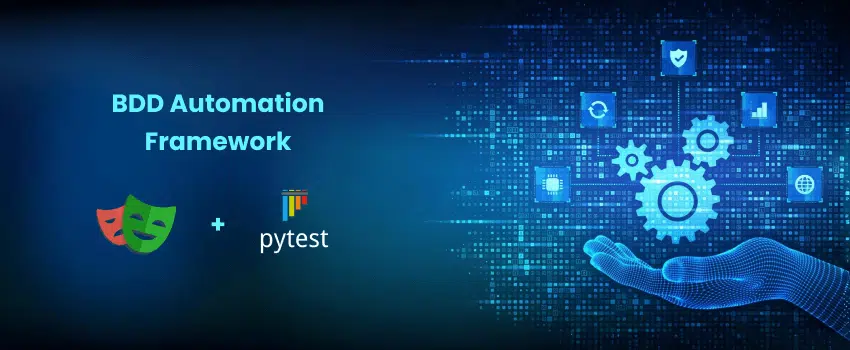Building a Scalable BDD Automation...
November 12, 2025

After evaluating several tools, we landed on Playwright + pytest-bdd a modern pairing that brings both power and simplicity to end-to-end (E2E) automation with Behavior-Driven Development (BDD) at its core. Mid-intro resource for deeper context: explore the official pytest-bdd documentation to understand step definitions, fixtures, and Gherkin mapping.
Playwright (by Microsoft) is one of the most reliable tools for cross-browser automation (Chromium, Firefox, WebKit), supporting network mocking, multi-context testing, and parallelism with excellent stability.
pytest-bdd brings Behavior-Driven Development (BDD) into the picture with Gherkin syntax (Given–When–Then) so both technical and non-technical stakeholders can read scenarios and collaborate.
Together, this stack gives us:
Feature (Gherkin):
Feature: Login functionality
Scenario: Successful login for valid user
Given the user is on the login page
When they enter valid credentials
Then they should be redirected to the dashboardStep Definitions (Python + Playwright + pytest-bdd):
from pytest_bdd import scenarios, given, when, then
from playwright.sync_api import expect
BASE_URL = "https://example.com"
TEST_USERNAME = "valid_user"
TEST_PASSWORD = "valid_pass"
scenarios("../features/login.feature")
@given("the user is on the login page")
def open_login_page(page):
page.goto(f"{BASE_URL}/login")
@when("they enter valid credentials")
def login(page):
page.fill("#username", TEST_USERNAME)
page.fill("#password", TEST_PASSWORD)
page.click("button[type='submit']")
@then("they should be redirected to the dashboard")
def verify_dashboard(page):
expect(page.locator("h1")).to_have_text("Dashboard")
This natural language style bridges the gap between QA, developers, and product so everyone can see what’s tested and why.
We built our BDD Automation Framework with Playwright to be scalable, modular, and CI-friendly:
Recommend Read: Secure Redis Cluster with Spring Boot and SSL Docker Setup
├── features/ # Gherkin feature files
│ ├── login.feature
│ ├── user_management.feature
│ └── settings.feature
│
├── tests/
│ ├── steps/ # Step definitions mapped from Gherkin
│ │ ├── login_steps.py
│ │ ├── user_steps.py
│ │ └── settings_steps.py
│ │
│ ├── test_login.py # Uses login_steps to validate login flows
│ ├── test_user_management.py # Uses user_steps to manage user scenarios
│ ├── test_settings.py # Uses settings_steps for configuration tests
│ │
│ ├── conftest.py # Shared pytest fixtures and hooks
│ ├── helpers.py # Common UI and API utilities
│ ├── s3_util.py # AWS S3 integration helpers
│
├── test-data/
│ ├── user_data.csv
│ ├── settings_data.json
│ └── env_specific_data/
│
├── reports/ # HTML & Allure reports
├── requirements.txt # Python dependencies
├── pytest.ini # Pytest config with markers and paths
├── .env # Environment-specific configurations
└── README.mdThe diagram shows how authored tests and steps run through config, fixtures, and utilities to drive the Playwright browser and produce reports and failure artifacts.
|
Layer |
Description |
|
Feature Files |
Plain-English behavior specs using Gherkin |
|
Step Definitions |
Executable Python steps mapped from Gherkin |
|
Test Scripts |
Orchestrate end-to-end flows using shared steps |
|
Fixtures (conftest.py) |
Setup/teardown, browser lifecycle, auth, and test state |
|
Helpers/Utilities |
Reusable UI/API functions, S3 utilities, data ops |
|
Test Data |
CSV/JSON per environment, role, or scenario |
|
Configuration |
.env + pytest.ini for runtime control, markers, and reporting |
[pytest]
markers =
smoke: Run smoke tests
regression: Run regression suite
demo: Run demo validations
addopts = -s -v --html=reports/report.html --self-contained-html
# Run all tests
pytest
# Run smoke suite
pytest -m smoke
# Generate HTML report
pytest --html=reports/report.html --self-contained-html
Report snapshot includes: pass/fail/skips, duration, environment, browser, and embedded screenshots for failures.
Test Suite: Smoke
Environment: https://dev.ourapp.com
Browser: Chromium
Passed: 25 | Failed: 0 | Skipped: 0
Duration: 4m 12s
| Metric | Before | After |
|---|---|---|
| Regression Execution Time | ~4.5 hours | 1.3 hours (↓71%) |
| Test Maintenance Effort | High | Reduced by 50% |
| Cross-Browser Coverage | Limited | Full (Chromium, Firefox, WebKit) |
| Test Stability | 85% pass | 98% stable runs |
| Collaboration | QA-only | QA + Dev + BA |
| Criterion | Playwright | Selenium |
|---|---|---|
| Speed & Stability | Very fast; auto-waits; isolated contexts | Can need more explicit waits |
| Browser Support | Chromium, Firefox, WebKit | Broad, varies by driver |
| Parallelism | First-class support | Possible, often more setup |
| DevTool Protocol | Native | Varies |
| Tooling | Codegen, Trace Viewer, Inspector | Third-party heavy |
For deeper BDD grounding, see Cucumber’s BDD guide (conceptually aligned with pytest-bdd’s approach to collaboration and living documentation).
# tests/conftest.py
import os
import pytest
from playwright.sync_api import sync_playwright
@pytest.fixture(scope="session")
def base_url():
return os.getenv("BASE_URL", "https://dev.ourapp.com")
@pytest.fixture(scope="session")
def browser_context_args():
return {"accept_downloads": True, "viewport": {"width": 1366, "height": 768}}
@pytest.fixture(scope="function")
def page(browser_context_args):
with sync_playwright() as p:
browser = p.chromium.launch(headless=True)
context = browser.new_context(**browser_context_args)
page = context.new_page()
yield page
context.close()
browser.close()
This structure keeps scenarios readable while the Python steps stay reusable. You get the best of both worlds: developer-grade automation + stakeholder-friendly specs.
It’s exactly what BDD Automation Framework with Playwright and BDD Automation Framework with pytest are designed to achieve clarity, speed, and scale.
Automation isn’t just “run scripts.” It’s building a self-sustaining ecosystem that scales with your product and team. With Behavior-Driven Development (BDD) via pytest-bdd and the speed of Playwright, our QA teams ship faster, communicate clearer, and maintain less while increasing coverage and stability.
If you’re exploring scalable, enterprise-ready test automation or want help aligning BDD with your delivery pipeline talk to an AI Development Agency and Company experienced in modern QA engineering and platform tooling.